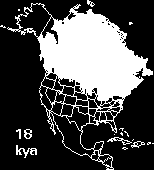

Forming The Landscape Glacial retreat began 14,000 ya due to a climate warming trend at the end of the Pleistocene glaciation. Meltwaters formed rivers that sculpted the landscape, transported debris, and displaced fossils. The environment was wet between the continental ice sheets for probably 1,000 years (Haynes Jr, 2000). Bogs and swamps were characteristic of the landscape once the glaciers retreated. Eventually wetlands dried up due to evaporation when temperatures warmed, and the vegetative landscape changed. The type of plant succession that occurred in North America depended on the climatic zone and regional environmental conditions. Between the glaciers, grasslands eventually covered the landscape to become what we know today as the Great Plains of North America. Some lakes and rivers remained. The Great Lakes and Great Slave Lake are examples of lakes that were left behind from glacier melt. The landscape also changed due to isostatic uplift, the slow raising of land once the weight of the thick ice sheets was removed. Isostatic uplift in the Hudson's Bay is ongoing today due to glaciel retreat.
One Pathway Opens As Another Closes An ice-free corridor was established between 12,000 and 11,000 ya (Haynes Jr, 2000) when the Cordilleran and Laurentide continental ice sheets were no longer in contact. The timing of this ice-free corridor is important to the dispersal of humans into the the Americas. We will address this controversy in the section about humans. Equally or more important was the reestablishment of the Bering and Chukchi seaway which currently joins the Arctic and Pacific oceans. Migration of fish and aquatic mammals, and the mixing of water and nutrients resumed. Once again maritime climates were established in Beringia.


